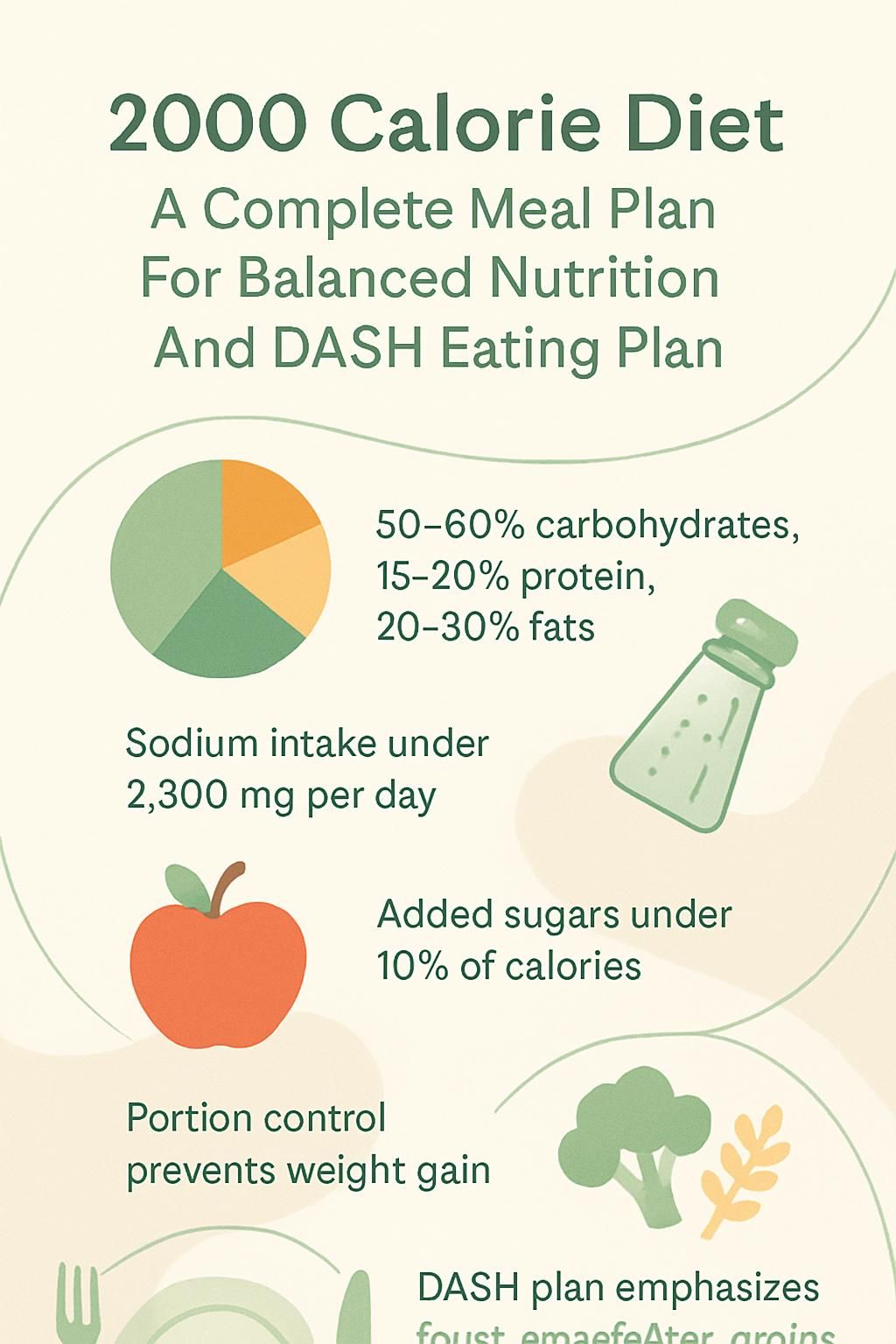2000 Calorie Diet: A Complete Meal Plan For Balanced Nutrition And Dash Eating Plan
Our Nutrition Assistant AI Suite will transform your body. You will lose fat, get toned, and build muscle. Gain confidence and optimal health.
You might wonder how much food you need each day for good health. A 2,000 calorie diet gives you a clear, practical target that fits many adults, and it is the basis for the nutrition label on foods in the United States. This guide shows you how to use that benchmark, read a nutrition label with confidence, and build a simple meal plan that follows the DASH eating plan to support heart health.
You will learn how to match calories to your activity level, pick foods that fuel your body, and plan meals that are balanced and satisfying. Small, steady changes add up. With a little structure, healthy eating becomes easier to stick with.
Key Takeaways
- The 2,000 calorie diet is the national reference for the nutrition facts label and MyPlate guidance used by the FDA and USDA.
- A helpful daily macronutrient split is about 50 to 60 percent carbohydrate, 15 to 20 percent protein, and 20 to 30 percent fat.
- The DASH eating plan fits a 2,000 calorie meal plan by emphasizing fruits, vegetables, whole grains, lean proteins, and keeping sodium under 2,300 mg per day.
- Portion control and regular meal timing aid weight management, and measuring foods improves calorie tracking.
- Limiting added sugars under 10 percent of calories, plus reducing saturated and trans fats and high sodium foods, supports heart health.

What is a 2,000-Calorie Diet?

A 2,000 calorie diet is an eating pattern that averages about 2,000 calories a day. It is a common reference that helps you compare foods, plan meals, and check your daily value on a nutrition facts label.
What does the 2,000-calorie standard mean?
Food packages list nutrients against a shared baseline called daily value. Those daily values are based on a 2,000 calorie diet. This lets you see how a single serving fits into a full day of eating.
For example, if a cereal shows 10 percent of daily saturated fat, that number assumes a 2,000 calorie day. The Food and Drug Administration requires this standard on the nutrition facts label, which makes products easier to compare. As the label itself reminds you, On most packages in the United States, daily values are based on a 2,000-calorie diet.
MyPlate, the USDA’s visual eating guide, also uses this level to set targets for fruits, vegetables, grains, protein foods, and dairy. Your personal needs can be higher or lower, based on age, sex, height, weight, and physical activity. The shared benchmark still helps you make quick, informed choices.
Why is 2,000 calories used as a benchmark?
Federal agencies selected 2,000 calories because it falls near the needs of many adults in the United States. Using one reference helps make labels, menus, and nutrition education consistent and easier to follow. The FDA bases the nutrition facts panel on this level, and the Dietary Guidelines for Americans use it as a common example (FDA, USDA, 2020-2025).
It is a guidepost, not a rule. Your goal might be higher or lower. The value still helps you compare foods and manage nutrients like sodium, saturated fat, and added sugars with less guesswork.
Understanding Calorie Needs
Calorie needs vary from person to person. Age, sex, height, weight, and activity level affect the number of calories you need to maintain your weight. A simple calculator can help you set a starting point, then you can adjust based on progress.
What factors affect how many calories I need?
Several things change your calorie needs:
- Age and life stage, such as adolescence or pregnancy.
- Sex, height, weight, and body composition.
- Daily activity level at work and during exercise.
- Weight goals, like weight loss, maintenance, or gain.
- Health conditions and medications that alter appetite or metabolism.
People with physically active jobs usually need more calories than people who sit most of the day. Tools like the MyPlate Calculator can give a tailored estimate using your data. Keep in mind that your needs shift if your activity or weight changes.
“After switching from a desk job to teaching outdoor classes five days a week, I felt tired until I increased both meals and snacks as my dietitian suggested.”
How do I calculate my daily calorie goal?
This easy method sets a starting point you can test and adjust:
- Find your current weight in pounds.
- Multiply by 12 for a rough maintenance estimate if you are mostly sedentary. Example: 190 pounds x 12 equals about 2,280 calories.
- For weight loss, subtract 500 calories for about one pound lost per week. For faster loss, subtract up to 750, but avoid very low intakes that miss nutrients.
- If you are very active, increase your estimate to match your higher energy use.
- Track your intake with a food diary or app to check accuracy and spot high sugar or snack calories.
- If you follow DASH or manage high blood pressure, track sodium along with calories.
- Reassess every few weeks and adjust for changes in activity, muscle mass, or goals.
- Ask a registered dietitian for a precise plan if you have medical needs.
This approach helps you control portion sizes while staying close to your nutrition targets.
Benefits of a 2,000-Calorie Diet
A 2,000 calorie diet provides structure without being rigid. It supports balanced nutrition, steady energy, and can help many adults maintain a healthy weight.
How does this diet support balanced nutrition?
A balanced meal plan includes variety from all food groups. You aim for fruits, vegetables, whole grains, beans, lean meats or fish, nuts, seeds, and dairy. A practical macronutrient split is about half your calories from carbohydrates, one fifth from protein, and the rest from fats.
Choosing mostly whole foods boosts fiber, vitamins, and minerals. Limiting sweets, sugary drinks, processed snacks, and refined grains supports heart health. People who follow DASH, a plan created to help lower blood pressure, often improve weight control and cholesterol too (NIH).
Is a 2,000-calorie diet good for weight maintenance?
Many moderately active adults maintain their weight near 2,000 calories a day. Maintenance happens when calories in match calories out. Your number can be different, though, based on body size, sex, age, and activity level.
If you burn fewer than 2,000 calories but eat that amount daily, you may slowly gain weight. A simple, nutritious meal plan helps you hit your target without feeling deprived.
How does it align with dietary guidelines?
The 2,000 calorie level matches examples used in the 2020-2025 Dietary Guidelines for Americans. MyPlate uses it to show how much to eat from each food group. Very low intakes, like under 1,200 calories, usually make it hard to get enough nutrients for most adults.
Building meals from fruits, vegetables, whole grains, lean or low-fat proteins, and dairy supports long-term health and digestive comfort. The shared benchmark makes tracking easier and more consistent across your week.
Macronutrient Distribution in a 2,000-Calorie Diet
Macronutrients are the major sources of energy in food: carbohydrates, proteins, and fats. Your split affects energy, appetite, and health markers like blood lipids. Small adjustments can make your diet feel more satisfying.
Carbohydrates: 50-60%
Aim for about 1,000 to 1,200 calories from carbohydrates each day, which equals 250 to 300 grams. Choose high fiber options like oats, brown rice, whole wheat bread, quinoa, beans, peas, and starchy vegetables such as sweet potatoes.
These foods support steady energy and healthy digestion. A simple breakfast example is whole grain toast with nut butter and a piece of fruit. Pick whole fruit more often than juice to get fiber and fewer added sugars.
Proteins: 15-20%
Target 300 to 400 calories from protein, about 75 to 100 grams daily. Quality sources include chicken, turkey, fish, eggs, yogurt, milk, tofu, tempeh, edamame, and beans or lentils.
Protein helps you feel full longer and supports muscle repair. Include a protein source at each meal. That habit improves appetite control and can reduce mid-afternoon cravings.
Fats: 20-30%
Aim for 400 to 600 calories from fat, or about 44 to 67 grams per day. Favor unsaturated fats such as olive oil, canola oil, avocados, nuts, seeds, and nut butters.
Fats help your body absorb vitamins A, D, E, and K, and they add flavor and satisfaction. Replacing saturated fats like butter with olive oil can help improve cholesterol levels over time.
Foods to Include in a 2,000-Calorie Diet
A 2,000 calorie plan leaves room for tasty, nutrient-dense foods. Mix and match options so your plate looks colorful and varied.
Which fruits and vegetables should I eat?
Fruits: berries, peaches, apples, pears, melons, bananas, and grapes all fit well. MyPlate suggests about 2 cups of fruit a day at this calorie level.
Vegetables: load up on kale, spinach, peppers, zucchini, broccoli, tomatoes, cauliflower, and other non-starchy choices. Add starchy vegetables such as sweet potatoes, winter squash, or white potatoes for energy. Aim for at least 2 to 3 cups of vegetables per day. This mix supports vitamins, minerals, and fiber, which help you feel full.
What whole grains fit this diet?
Choose brown rice, oats, bulgur, quinoa, farro, barley, or whole grain breads and pasta. MyPlate suggests about six ounce-equivalents of grains daily on a 2,000 calorie plan, with at least half from whole grains.
As a guide, one slice of whole grain bread or half a cup of cooked brown rice equals one ounce-equivalent. Swapping refined pasta for quinoa or adding nuts and seeds to oatmeal boosts fiber and nutrients without added sugars.
What are good sources of lean proteins?
Lean meats such as chicken and turkey, plus lean cuts of beef or pork, fit well in this meal plan. Fish and seafood like salmon, tuna, cod, shrimp, and scallops provide protein with fewer calories and, for fatty fish, heart-friendly omega-3 fats.
Plant proteins include beans, lentils, chickpeas, tofu, tempeh, and edamame. These options supply fiber and minerals along with protein. Many people combine both animal and plant sources to meet their needs and keep meals interesting.
Which healthy fats are recommended?
Pick fats that support heart health: avocados, olives, olive oil, canola oil, nuts, seeds, and natural nut butters. These foods provide mostly unsaturated fats and come with useful nutrients like vitamin E and magnesium.
For dairy, MyPlate suggests about 3 cups daily at the 2,000 calorie level. Choose fat-free or low-fat milk and yogurt most often. Cheese can fit in small portions. Fortified soy milk or yogurt works for people who avoid dairy while still getting calcium and protein.
Foods to Avoid or Limit
Some foods crowd out nutrients or add more calories, sugar, or salt than you need. Limiting them makes room for better choices while keeping your daily calorie intake on track.
What processed and sugary foods should I avoid?
Keep added sugars under 10 percent of calories. That means limiting soda, sweetened tea, flavored coffee drinks, fruit punch, candy, ice cream, and pastries. Many breakfast cereals and snack bars also carry a lot of sugar.
Refined grains like white bread, regular pasta, crackers, and chips raise calories fast but do little for fullness. Switching to whole grain toast instead of a morning bagel can steady blood sugar and reduce mid-morning slumps.
Why limit saturated and trans fats?
Too much saturated fat and any trans fat can raise LDL cholesterol, the type that increases heart disease risk. Common sources include fried foods, doughnuts, packaged desserts, and some shelf-stable snacks.
Cook with olive or canola oil, and choose lean cuts of meat. These swaps support a healthy heart over time. People often see improvements in cholesterol after a few months of consistent changes.
How do high-sodium foods affect health?
High-sodium foods such as fast-food fries, hot dogs, pizza, and chicken nuggets can raise blood pressure. The American Heart Association suggests keeping sodium under 2,300 milligrams per day for most adults, and lower limits may be advised for some people.
Use the nutrition facts label to compare sodium. Pick lower sodium versions and flavor food with herbs, spices, citrus, and vinegar. These steps fit the DASH eating plan and support long-term heart health.
Sample 3-Day Meal Plan
Use this sample to spark ideas. Portions are examples that land near 2,000 calories a day for many people. Adjust as needed based on your calorie needs and activity level.
What does Day 1 look like for meals and snacks?
Breakfast: a vegetable omelet with 2 eggs, 1 cup spinach, 1/4 cup mushrooms, and 1/4 cup broccoli. Serve with sautéed sweet potatoes cooked in 1 tablespoon olive oil.
Snack: an apple with 2 tablespoons peanut butter.
Lunch: Mediterranean tuna pita with whole wheat pita, 5 ounces tuna, chopped red onion and celery, 1/4 avocado, and 1 tablespoon feta.
Snack: 2 ounces cheddar cheese and 1 cup grapes.
Dinner: 5 ounces salmon drizzled with 2 tablespoons olive oil, 1/2 cup wild rice, plus 1 cup asparagus and 1 cup eggplant. This day balances protein, fiber, and healthy fats to keep energy steady.
What meals and snacks are included on Day 2?
Breakfast: nut butter banana toast on whole grain bread for fiber, potassium, and healthy fats.
Snack: a smoothie of leafy greens and berries. Use unsweetened milk or yogurt for protein and less sugar.
Lunch: avocado tuna salad on greens or whole grain bread. Avocado adds monounsaturated fat, while tuna supplies lean protein.
Snack: a black bean burrito for plant protein and complex carbohydrates. Another snack option is crunchy vegetables with hummus.
Dinner: chicken and broccoli stir-fry over brown rice. You get lean protein, fiber, and vitamins C and K in one bowl.
What is a balanced meal plan for Day 3?
Breakfast: berry yogurt parfait for calcium, protein, and vitamin C.
Snack: one banana with 1.5 tablespoons, about 24 grams, of almond butter for potassium, fiber, and healthy fat.
Lunch: 3/4 cup, about 132 grams, rice noodles with 5 ounces, about 141 grams, tofu and 1/2 cup, about 125 grams, peas. Sauce: 1 tablespoon, 16 grams, peanut butter, 2 teaspoons, 10 grams, tamari, 1/2 teaspoon, 2 grams, Sriracha, 2 teaspoons, 14 grams, honey, and juice from half a lime.
Snack: a protein bar with 200 to 250 calories, at least 5 grams fiber, and under 12 grams sugar.
Dinner: three corn tortillas topped with 6 ounces, about 170 grams, grilled cod, 1/2 avocado, and 2 tablespoons, about 34 grams, pico de gallo. These meals combine carbs, protein, and fat so your total lands near 2,000 calories.
The DASH Eating Plan
DASH stands for Dietary Approaches to Stop Hypertension. It is a structured way of eating that lowers blood pressure through balanced meals and lower sodium intake.
What is the DASH diet?
DASH encourages more fruits, vegetables, whole grains, lean proteins like poultry or fish, beans, and low-fat dairy. It limits sodium, added sugars, and saturated fat. Many people see meaningful blood pressure improvements within two weeks of following DASH principles (NIH, AHA).
A typical day might include oatmeal with berries at breakfast, a salmon salad for lunch, and roasted chicken with steamed broccoli at dinner. Using herbs, citrus, and spices helps you rely less on the salt shaker.
How does the DASH diet complement a 2,000-calorie plan?
DASH fits easily into a 2,000 calorie meal plan. You can aim for about 6 to 8 servings of grains, 4 to 5 servings of vegetables, up to 5 servings of fruit, 2 to 3 servings of low-fat dairy, and 6 or fewer one-ounce servings of lean proteins daily. Keep sodium under 2,300 mg, or lower if advised by your clinician.
These targets align with MyPlate and the Dietary Guidelines. Clear serving goals make shopping and meal prep more straightforward.
Tips for Meal Prep and Planning
Planning helps you meet your calorie target, reduce stress, and avoid last-minute takeout. A little time upfront saves time all week.
How can I create a weekly menu?
Use MyPlate and the USDA Shop Simple tools to build a menu that covers all food groups. Plan breakfast, lunch, dinner, and snacks for the week so portions and calories stay on track.
- Map out 2 to 3 breakfast ideas and rotate them.
- Pick 2 lunches you can batch cook, such as grain bowls or soups.
- Select 3 to 4 dinners that share ingredients to reduce waste.
- List grab-and-go snacks like fruit, yogurt, nuts, or cut vegetables.
This approach simplifies grocery shopping and reduces food waste while supporting balanced nutrition.
What are the benefits of prepping ingredients ahead?
Prepping saves time, supports portion control, and makes it easier to follow your plan on busy days. Wash and chop vegetables, cook whole grains, and portion proteins in advance.
Home-prepared meals often contain less sodium, added sugar, and unhealthy fats compared with restaurant meals. Pre-portion snacks into small containers to make smart choices automatic.
How do I add variety to avoid meal monotony?
Rotate fruits, vegetables, grains, and proteins across the week. Use herbs and spices like ginger, turmeric, oregano, basil, and parsley to create new flavors without extra calories.
Try themes to keep things fresh: Mediterranean on Monday, tacos on Tuesday, stir-fry on Wednesday. Swap brown rice for quinoa, salmon for lentils, or apples for berries to change texture and taste while maintaining nutrition.
Common Mistakes to Avoid
A few small missteps can stall progress. Spot them early and you will see better results from the same effort.
Why is ignoring portion sizes a problem?
Oversized portions add more calories than you think. That can lead to weight gain over time, even with healthy foods. MyPlate serving sizes help you judge portions without guesswork.
Use measuring cups, a food scale, or your hand as a quick guide. Consistent portions make calorie tracking much more accurate.
What happens if I skip meals?
Skipping meals often backfires. Hunger builds and you may overeat later. Blood sugar swings can also hurt energy and focus.
Try to eat at steady times. A small protein-rich snack can bridge longer gaps and prevent overeating at the next meal.
How can overconsuming calorie-dense snacks affect me?
Calorie-dense snacks like chips, cookies, and candy can push you over 2,000 calories without filling you up. Two handfuls of chips can add around 300 calories with little nutrition.
Swap in fruit with nuts or yogurt with berries. These choices satisfy hunger with protein and fiber, so you stay on track.
Who Can Benefit from a 2,000-Calorie Diet?
Many adults do well with this target, especially if they are moderately active. Your best number still depends on your daily routine and health goals.
Is this diet right for moderately active people?
Yes. If you walk briskly or do light exercise for 30 to 60 minutes most days, 2,000 calories may fit your energy needs. The mix of nutrients supports recovery and steady energy.
USDA estimates place most healthy adults between 1,800 and 2,400 calories per day, depending on activity. Adjust if your workouts become more intense or less frequent.
Can it help those wanting to maintain weight?
A 2,000 calorie plan can maintain weight if it matches your energy use. Choose mostly whole foods, track portions, and keep an eye on snacks and beverages.
Many people use an app to monitor intake and stay close to their daily goal. That simple habit reduces unplanned overeating.
Who benefits from this diet when managing high blood pressure?
People with high blood pressure often see benefits with a 2,000 calorie DASH meal plan. Lower sodium and higher potassium-rich foods like fruits and vegetables can reduce blood pressure (NIH, AHA).
Focus on whole foods, lean proteins, and plenty of produce. Prepare more meals at home to control sodium and keep portions consistent.
Consulting a Dietitian or Nutritionist
Professional guidance helps you fine-tune calories and nutrients to your goals, health history, and preferences. It is especially helpful if you have medical conditions.
Why is personalized dietary advice important?
Your needs are unique. A dietitian considers your age, activity level, medical conditions, medications, and goals to build a safe plan that covers all nutrients.
Targeted guidance reduces the risk of deficiencies and helps you adjust protein, fiber, and calories for your lifestyle, including sports training or physically demanding work.
When should I seek professional nutrition guidance?
Seek help if you have diabetes, kidney disease, hypertension, digestive disorders, or food allergies. People who are pregnant, breastfeeding, or training for sports also benefit from expert support.
Unexpected weight changes or confusion about how many calories you need are other good reasons. A registered dietitian can design a balanced 2,000 calorie meal plan, or a better-fitting target, and help you monitor progress safely.
Frequently Asked Questions
Here are clear answers to common questions about a 2,000 calorie diet and healthy eating.
Can a 2,000-calorie diet help me lose weight?
It can if it creates a calorie deficit. If you eat 2,500 calories now and reduce to 2,000, you might lose about one pound per week. That estimate comes from the idea that a 3,500 calorie deficit equals roughly one pound of fat.
Results vary with age, sex, height, weight, and activity. The 2,000 calorie level is a helpful starting point that supports balanced nutrition while you reduce calories safely.
Is this diet suitable for specific health conditions?
Yes, with adjustments. The DASH eating plan, which fits a 2,000 calorie structure, supports people managing high blood pressure and heart risk. People with diabetes may change carbohydrate amounts and timing while staying near 2,000 calories.
Work with your healthcare provider or a registered dietitian. Professional advice ensures your plan meets your medical needs and still fits your daily life.
Conclusion
A 2,000 calorie diet offers a simple framework for balanced nutrition and steady energy. Use the nutrition label, plan regular meals and snacks, and fill your plate with fruits, vegetables, whole grains, lean proteins, and healthy fats.
The DASH eating plan fits neatly within this structure and supports heart health through lower sodium and nutrient-rich foods. If you need extra guidance, ask a dietitian to customize your meal plan. This information is educational and does not replace medical advice. Your best diet matches your goals, health status, and activity level, and it should be enjoyable enough to sustain day after day.
FAQs
1. What is a 2000 calorie diet and how does it support balanced nutrition?
A 2000 calorie diet provides an average daily energy intake for most adults, supporting healthy weight maintenance. This meal plan includes grains, lean proteins like chicken or fish, fruits, vegetables, low-fat dairy products such as yogurt or milk, and healthy fats from sources like olive oil or nuts. The approach aligns with recommendations from the Dietary Guidelines for Americans and helps ensure you get essential vitamins and minerals.
2. How does the DASH eating plan fit into a 2000 calorie meal plan?
The DASH eating plan focuses on reducing sodium while increasing foods rich in potassium, calcium, magnesium, and fiber. It encourages whole grains such as brown rice or oats; fresh produce including berries or spinach; lean meats; beans; seeds; and limited added sugars. Research shows that following this pattern can lower blood pressure in people with hypertension (Sacks et al., New England Journal of Medicine).
3. Can I personalize my meals within a 2000 calorie diet to meet specific health needs?
Yes. You can adjust food choices based on preferences or medical advice while staying within your daily limit of calories. For example, if you have lactose intolerance you might choose fortified plant-based milks instead of cow’s milk but still maintain adequate calcium intake.
4. What are some sample foods included in a complete 2000 calorie meal plan?
Sample foods include oatmeal with berries at breakfast; grilled turkey breast sandwich with lettuce at lunch; roasted salmon fillet with steamed broccoli at dinner; snacks could be apple slices or almonds between meals. Each item contributes nutrients needed for balanced nutrition according to evidence-based guidelines.
Summary: A structured 2000 calorie diet supports overall health by providing key nutrients through varied food groups while allowing flexibility for individual needs when combined with the DASH eating principles.







